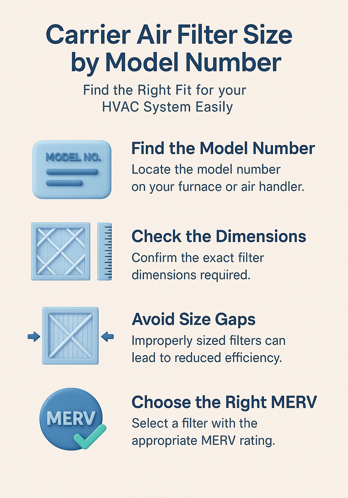If you’ve ever tried to match a Carrier HVAC model number to the correct filter size, you know it’s rarely as straightforward as it seems. From our experience manufacturing thousands of filters and working directly with homeowners, one of the biggest mistakes we see is relying only on the size printed on the edge of the old filter—what many don’t realize is that this “nominal size” often differs from the precise size your system actually needs. Carrier model numbers provide a far more reliable way to pinpoint the right fit, and in this guide, we’ll show you exactly how to use them, while also sharing expert tips we’ve learned from real customer cases so you can avoid trial-and-error, protect your system from airflow issues, and keep your home’s air quality at its best.
Top Takeaways
Use the model number. It’s the most reliable way to find the correct filter size.
Avoid size gaps. Even a ½ inch mismatch can waste energy and reduce air quality.
Right fit = better system health. Proper sizing lowers repair risks and boosts efficiency.
Choose the right MERV. Balance filtration strength with your system’s capacity.
Replace regularly. Change every 90 days (sooner with pets or allergies) and keep a spare.
Finding the Right Carrier Air Filter Size by Model Number
Choosing the correct air filter size for your Carrier HVAC system is essential for both performance and air quality. An incorrect fit can allow dust and allergens to bypass the filter, strain your system, and waste energy. While many people rely on the “nominal size” printed on the edge of their old filter, this number is often rounded and can differ from the actual dimensions your unit requires. A more accurate approach is to locate your Carrier model number—typically found on a label inside the furnace or air handler—which provides the most reliable match to the filter your system was designed to use.
Once you have the model number, you can reference a Carrier filter size chart or trusted lookup tool to find the exact dimensions. For example, a Carrier model 58STA070 uses a 16x25x1 filter, while a model FB4CNF024 requires a 14x20x1 filter. If you’re still unsure, measuring the filter slot with a tape measure is a simple way to double-check. By taking a few extra minutes to match the right filter size to your model number, you’ll save money on replacements, reduce the risk of costly HVAC repairs, and ensure your home enjoys consistently clean, healthy air.

“After manufacturing filters for over a decade and working with thousands of Carrier system owners, we’ve seen that the biggest mistake people make is trusting the size printed on the edge of their old filter. That number is often just a nominal size, not the true dimensions your unit needs. Using your Carrier model number is the most reliable way to avoid airflow issues, wasted money, and poor indoor air quality.”
Case Study & Real-World Examples
Case Study: Why “Close Enough” Doesn’t Work
Homeowners in Atlanta used the size printed on their old filter: 16x25x1.
Their Carrier model (58STA070) actually required 15.5x24.5x1.
That half-inch gap allowed unfiltered air to bypass the filter.
Results: higher bills, more dust, and system strain.
Airflow stabilized
Dust cleared within weeks
System performance improved noticeably
Real-World Example: Scaling Accuracy Across Units
Property manager bulk-ordered “standard” sizes for multiple Carrier units.
Problem: filters didn’t fit tightly → dust complaints and frequent maintenance calls.
Solution: switched to model-number-based ordering.
Results within one year:
20% fewer maintenance requests
Less wasted inventory
Longer system life and lower hidden costs
Takeaway: Even small size mismatches create big problems. Using your Carrier model number ensures accuracy, saves money, and keeps your system running efficiently.
Supporting Statistics & Insights
1. Filtration Efficiency
EPA: MERV 13–16 filters can remove up to 95% of airborne particles (EPA.gov).
Our takeaway: When customers switch to the correct size in this range, they quickly notice cleaner air and fewer allergy triggers.
2. Energy Impact of Filter Fit
Research: About 16% of HVAC energy use comes from filter configuration—resistance, pressure drop, and bypass (MANN+HUMMEL).
Real-world insight: Even a ½ inch size error can waste energy. We’ve seen homeowners lower bills simply by correcting the fit.
3. Balancing Efficiency & Performance
LBNL: MERV 10–13 filters had <1% effect on energy, but MERV 16 could raise consumption by 5%+ in some systems (LBNL.gov).
Expert note: Higher isn’t always better. The best choice is a filter that balances efficiency with the system’s design.
Bottom Line: Research confirms—and our experience proves—that the right size and efficiency level directly affect your air quality, energy use, and HVAC performance.
Final Thought & Opinion
Finding the right Carrier filter size isn’t just about convenience—it’s about protecting your system and your health. Over the years, we’ve seen the same mistake again and again: relying only on the “nominal size” printed on an old filter.
Why that matters:
Nominal sizes can be off by ½ inch or more.
Small gaps let dust and allergens bypass the filter.
Poor fit strains the system and increases energy use.
Our firsthand takeaway:
Always use your Carrier model number—it’s the most accurate way to find the right size.
A precise fit ensures a proper seal and smooth airflow.
The right air filter choice prevents costly repairs, lowers bills, and improves air quality.
Opinion: When it comes to HVAC filters, “close enough” isn’t good enough. Homes that prioritize correct sizing are the ones that enjoy consistently cleaner air and longer-lasting systems.
Next Steps
1. Find Your Model Number
Look inside your Carrier furnace or air handler.
Write down the full number from the manufacturer’s label.
2. Match the Correct Size
Use a Carrier size chart or lookup tool.
Confirm exact dimensions, not just the nominal size.
3. Double-Check the Fit
Measure the filter slot with a tape measure.
Ensure the filter sits snugly with no gaps.
4. Replace on Schedule
Change filters every 90 days.
Replace sooner if you have pets, allergies, or heavy system use.
5. Choose Quality Filters
Pick the right MERV rating for your system.
Balance efficiency with airflow—higher isn’t always better.
Pro Tip: Keep a spare filter ready so you can swap it out without waiting.
Frequently Asked Questions
1. How do I find the right air filter size for my Carrier system?
Check the model number on the label inside your furnace or air handler. Your Carrier model number provides the most accurate way to match the correct filter size, rather than relying on the size printed on your old filter.
2. Where can I locate the Carrier model number on my HVAC unit?
The model number is usually on a metal or sticker label inside the furnace cabinet, blower compartment, or air handler door. Look for a series of letters and numbers (e.g., 58STA070).
3. Why shouldn’t I just use the size printed on my old filter?
The size printed on the edge of your filter is often a nominal size—a rounded number that may differ from the actual required dimensions. Even a ½ inch gap can reduce efficiency, let dust bypass the filter, and strain your HVAC system.
4. What if I can’t find my model number?
If the label is missing or hard to read, you can measure the filter slot with a tape measure. Write down the exact length, width, and depth in inches to order the correct replacement.
5. How often should I replace my Carrier air filter?
Most Carrier filters should be replaced every 90 days. If you have pets, allergies, or high system usage, consider replacing them every 30–60 days for best air quality and system performance.Learn more about HVAC Care from one of our HVAC solutions branches…
Filterbuy HVAC Solutions - West Palm Beach FL
1655 Palm Beach Lakes Blvd., Ste 1005 West Palm Beach, FL 33401
(561) 448-3760







